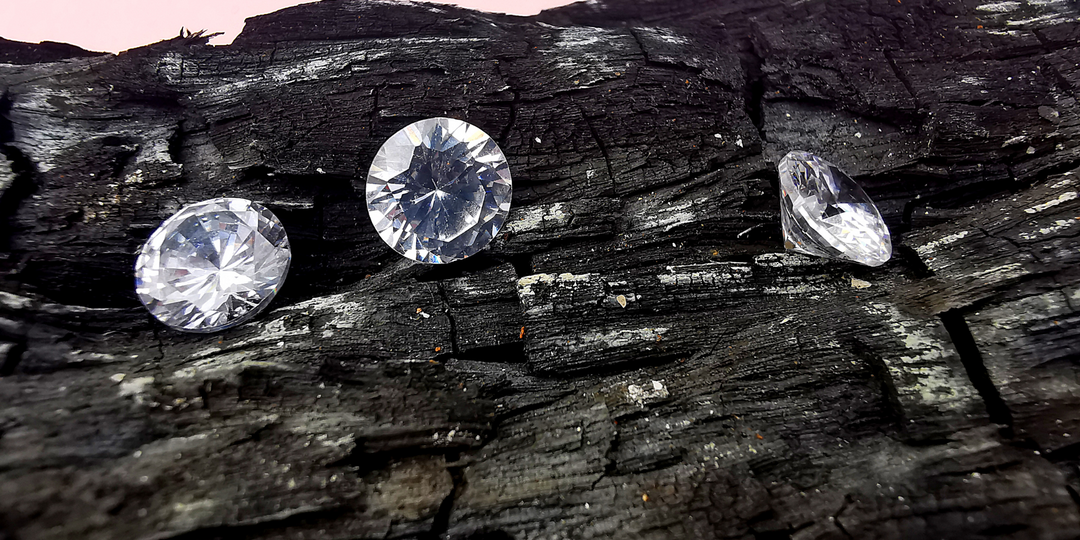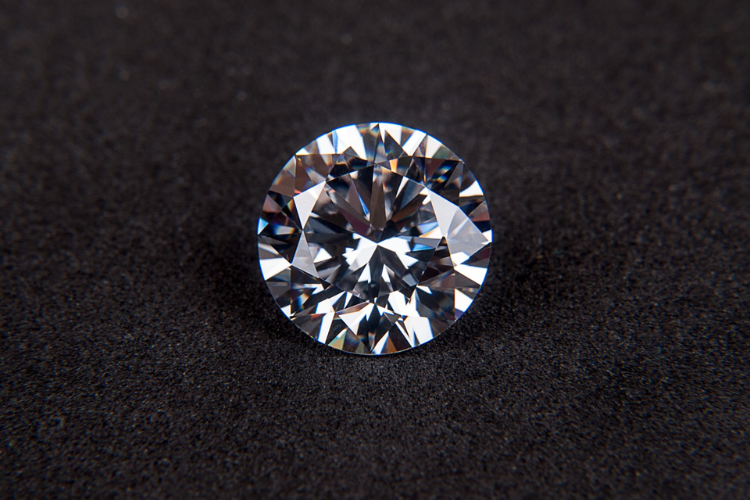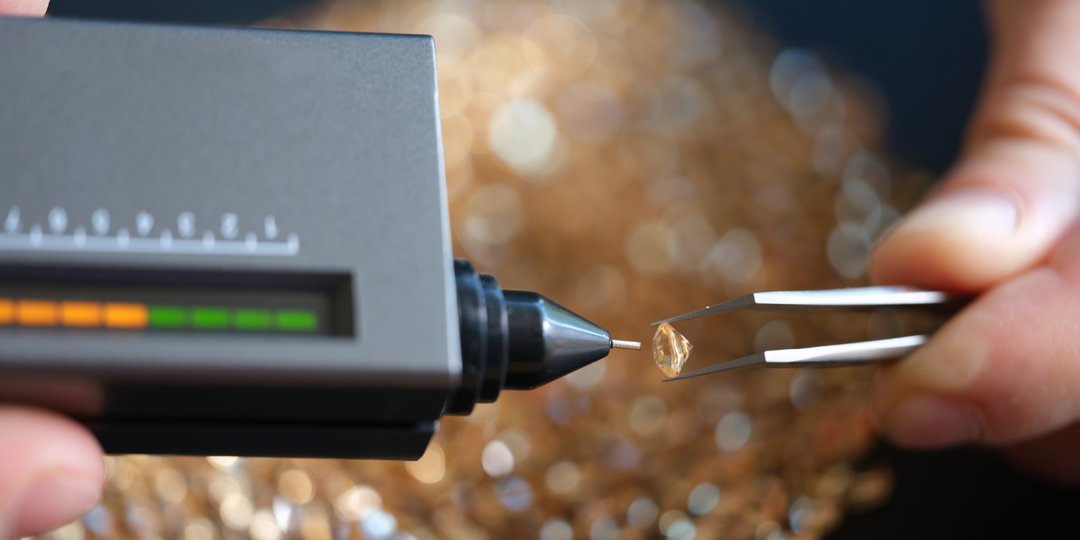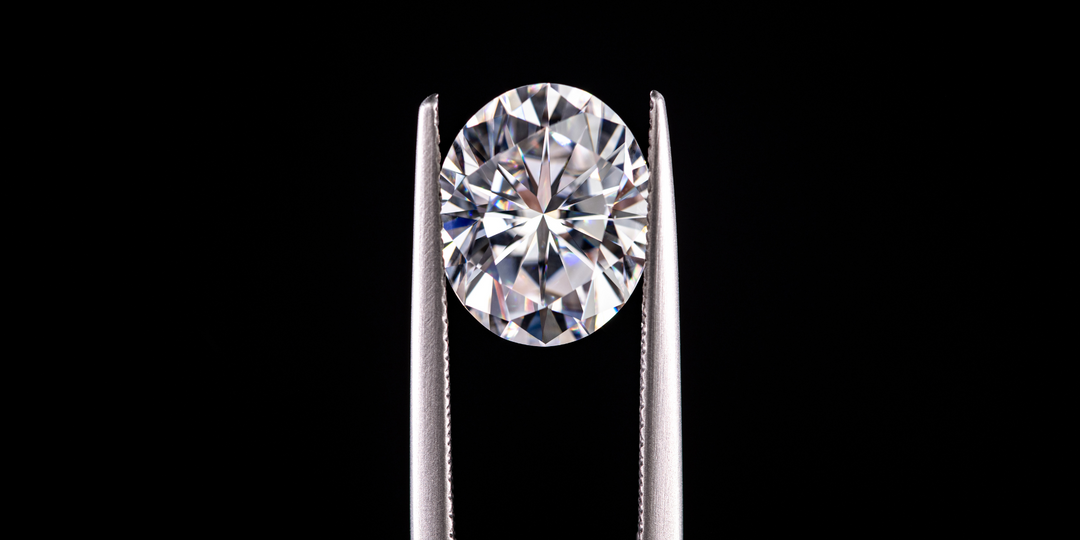Lab Grown Diamonds Vs Moissanite: What is the Difference?
Of all the precious gems on Earth, the diamond stands incomparable in value and allure. From its sheen and shape to aesthetics, there’s no doubt why Marilyn Monroe said, “diamonds are a girl’s best friend”. Diamonds, as we used to know, are naturally occurring, unpolished stones deep inside the Earth and extremely expensive.
However, with advanced technology coming into the scene, we now have excellent alternatives to mined diamonds - yes, still real diamonds, only grown in labs. They’re more sustainable, affordable, and, of course, as beautiful as their natural counterparts.
While researching lab diamonds, you may have come across another option - Moissanite. And certainly, you must be wondering which one is better - Moissanite vs. lab grown diamonds? Or are the two very different? To help clear your confusion, in this blog, we’ll walk you through the distinguishing factors between Moissanite and lab grown diamonds and how to differentiate one from the other. So, stay tuned!
What Is Moissanite?
Perhaps you’re thinking Moissanite is a type of lab grown diamond, but surprise! It’s neither a natural nor lab grown diamond, and yet it’s still an incredible gem.
Interestingly, Moissanite is named after Henri Moissan, a French scientist who discovered silicon carbide in a meteorite crater in Arizona, USA, in 1893. The stone Moissanite is naturally occurring and also contains the same element, silicon carbide (SiC).
Natural Moissanite is very rare and usually found in meteorites and certain types of volcanic rock. Cut to present times, Moissanite is grown in labs under controlled conditions, through a process called thermal growing of silicon carbide crystals.
Lab grown Moissanite involves exposure to high pressure and temperature, mimicking a diamond’s natural formation process. However, in contrast to lab grown diamonds, Moissanite possesses a different chemical composition. As it is known, diamond is pure carbon, but that’s not the case with Moissanite - this distinct gem is a blend of both carbon and silica.
Moissanite is often considered a substitute for diamond, owing to its similar appeal and attributes like brilliance and a high refractive index, akin to natural diamonds. The best part is that Moissanite isn’t as expensive as diamond, and all the credit goes to its varied chemical composition and physical qualities. For instance, Moissanite’s hardness fetches a score of 9.25 on the Mohs scale - this is a little less than diamond, which records a score of 10.
What Are Lab Grown Diamonds?
A lab grown diamond is also called a cultured diamond. It’s man-made diamonds. That’s right! Diamonds can also be created in a laboratory environment, leveraging cutting-edge technology.
There are two methods used to create lab grown diamonds:
- High-pressure high temperature (HPHT)
-
Chemical Vapor Deposition (CVD)
These methods imitate the original conditions under which natural diamonds are born, but in a controlled environment and at a much faster pace. lab grown diamonds appear identical not only physically but chemically too, which reason why many consider lab grown diamonds as natural diamonds (and we don’t blame them!). Lab diamonds are also graded using natural diamond criteria and can be cut, polished, or embedded to design a beautiful piece of jewelry.
Like natural diamonds, lab diamonds also possess electrical, thermal, and optical properties. Now, what does this mean? It simply means you can still consider them as real diamonds and it’s not wrong - amazing, isn’t it?
The crucial difference between lab grown diamonds and their natural counterpart lies in their formation process. As we all know, natural diamonds take millions of years to be formed. However, lab grown diamonds are created in controlled environments, and it’s just a matter of a few weeks or months before you can lay your hands on a lab diamond!
And that’s the sole reason why lab diamonds are affordable, compared to natural diamonds. So, if you’re obsessed with diamonds but looking for a more affordable alternative, lab grown diamonds are your perfect choice - firstly because it doesn’t cost a fortune and secondly, they’re environmentally more sustainable.
Key Differences Between Lab Grown Diamonds Vs. Moissanite
| Feature | Lab Grown Diamonds | Moissanite |
|---|---|---|
| Composition | Mostly carbon atoms in a special crystal structure. | Mostly silicon carbide (SiC) with silicon and carbon atoms. |
| Structure | Cubic crystal lattice, similar to natural diamonds. | Hexagonal crystal structure, unique optical properties. |
| Color Range | Colorless to various shades (yellow, blue, pink, etc.). | Almost colorless, slight yellow or grey tint, rainbow effect. |
| Color Quality | High-quality looks colorless or similar to high-grade natural diamonds; lower-grade may have tints. | Nearly colorless, but more color compared to diamonds under certain lights. |
| Variety | Available in various shapes and sizes like natural diamonds. | Available in various shapes, but may look different in certain lighting. |
| Appearance | Look like classic diamonds with high brilliance and clarity. | Distinct sparkle with a higher refractive index and colorful flashes. |
| Brilliance | High brilliance, similar to natural diamonds. | Higher fire and brilliance, often with rainbow-like flashes. |
| Durability | Hardness of 10 on the Mohs scale; highly resistant to scratches and daily wear and tear. | Hardness of 9.25 on the Mohs scale; still resistant to scratches and suitable for everyday wear. |
| Longevity | Maintains brilliance and structural integrity over time. | Retains sparkle and brilliance, but may be more susceptible to minor abrasions compared to diamonds. |
| Cut | Same cuts as natural diamonds (round, princess, etc.). | Similar cuts, but optimized for its unique optical properties. |
| Clarity | Similar to natural diamonds, with inclusions possible. | Generally high clarity, but may have needle-like inclusions. |
| Hardness | 10 on the Mohs scale. | 9.25 on the Mohs scale. |
1. Allure and Appearance
When you compare natural diamond vs lab grown vs Moissanite, the most astonishing fact is that they all look the same initially. Honestly, only an expert professional can tell the difference between the three. Nevertheless, on comparing lab grown vs Moissanite, certain differences are visible that’ll help you distinguish one from the other.
If there were a contest, “Who sparkles more?” Moissanite would have won the first prize since it sparkles more than both lab grown and natural diamonds. Its high refractive index of 2.65 to 2.68 is the sole factor, unlike in diamond, which is 2.45. Thus, in contrast to a diamond’s classic white brilliance, Moissanite dazzles with an astounding rainbow-like sparkle.
2. Color
Diamonds, as you know, are usually colorless, and both lab-made diamonds and Moissanite are nearly or completely colorless too. While colorless diamonds fall in grades D, E, and F, subtle yellow or colorless options come under grades G, H, I, and J. The pricing depends on this color factor - the more colorless it is, the more expensive the diamond.
Did you know? Colorless Moissanite is white and crystal clear, and similar to D, E, and F diamonds. On the other hand, nearly colorless Moissanite is equivalent to G, H, and I graded diamonds and carries a slightly warmer hue. Wish Moissanite offered more color options? It does - grey, cyan, yellow, and green - pick whichever shade you love!
3. Visual Comparison
If you’re asked to distinguish Moissanite vs. lab grown diamonds just based on clarity, you might end up saying, “But they all look the same”, and that’s correct. A majority of diamonds possess natural flaws due to their formation process under extreme pressure and temperatures. As a result, the brilliance of the stone is directly linked to a specific type of flaw.
While both lab grown and Moissanite may appear clear, sparkly, and can be cut into wonderful shapes, there still lies a significant difference between the two. Lab grown diamonds come with physical, chemical, and optical properties similar to natural diamonds, meaning they reflect light in such a way that they showcase a true white brilliance.
Sharp and crisp is how we would describe the sparkle of lab grown diamonds. On the other hand, Moissanite has a higher refractive index, the main reason why Moissanite gives off a more intense, rainbow-like sparkle. Although beautiful in its way, this distinct color play is often the easiest way to differentiate a Moissanite vs lab grown diamond.
4. Durability and Longevity
If you’re wondering whether lab grown diamonds are more durable than Moissanite, the answer is yes! As mentioned earlier, lab grown diamonds are identical to their natural counterpart, which implies the former scores a perfect 10 on the Mohs scale of hardness. No wonder lab grown diamonds are highly resistant to scratches, making them perfect for everyday wear, especially as heirloom pieces or an engagement ring.
They stand out for their longevity and strength, making lab-made diamonds a top choice for anyone desiring timeless, lifelong sparkle. Moissanite is also a strong gemstone, having a 9.25 score on the Mohs scale, making it second only to diamonds. They’re undoubtedly resilient and suitable for daily wear, but they’re slightly more susceptible to surface abrasions over time.
5. Price and Value: What Should You Choose?
Curious to know Moissanite vs lab grown diamond price? The fact is that both Moissanite and lab grown diamonds can be budget-friendly. However, the former’s price mainly depends on the difference between Premium and Super Premium color grading and size.
One of the primary reasons why lab grown diamonds are a preferred option is because of their affordability. lab grown diamonds from reputable manufacturers like CaratBee are available at a much lower price than natural diamonds; this isn’t because of any difference or issue with quality.
The truth is that CaratBee’s lab grown diamonds are completely created without any mining, middleman, or industry markups. With no traditional supply chains or cartels being involved, we can provide ethically crafted lab grown diamonds at a price that’s truly reasonable and transparent.
Popular Settings and Styles
When it comes to selecting lab grown diamonds vs. Moissanite, the setting and style you choose can often enhance the uniqueness and beauty of each stone. Traditional and timeless settings, like solitaires, three-stone rings, and halos, are often the reasons why lab grown diamonds are preferred. Their indistinguishable appearance from natural diamonds makes them a top choice for engagement rings or fine jewelry, providing the exact elegance and brilliance, but in an affordable and ethical space.
Moissanite is well-known for its rainbow sparkle and alluring fire, dominating modern or alternative styles. Whether in vintage-inspired settings or nature-themed designs, Moissanite looks wonderful, displaying its vibrant play of color.
Conclusion
Now, there you go! lab grown diamonds and Moissanite may appear to be the same and share nearly similar attributes, but they’re certainly different. If a diamond is your true love but you want something more affordable and environmentally friendly (and also looks like a diamond), Moissanite or lab grown diamond is your perfect choice for so many great reasons. Discover a stunning collection of lab-made diamond and Moissanite rings at CaratBee. Explore thousands of cuts, styles, and designs tailored to your budget and preferences. Shop confidently with free shipping, exchange, or 30-day returns.







